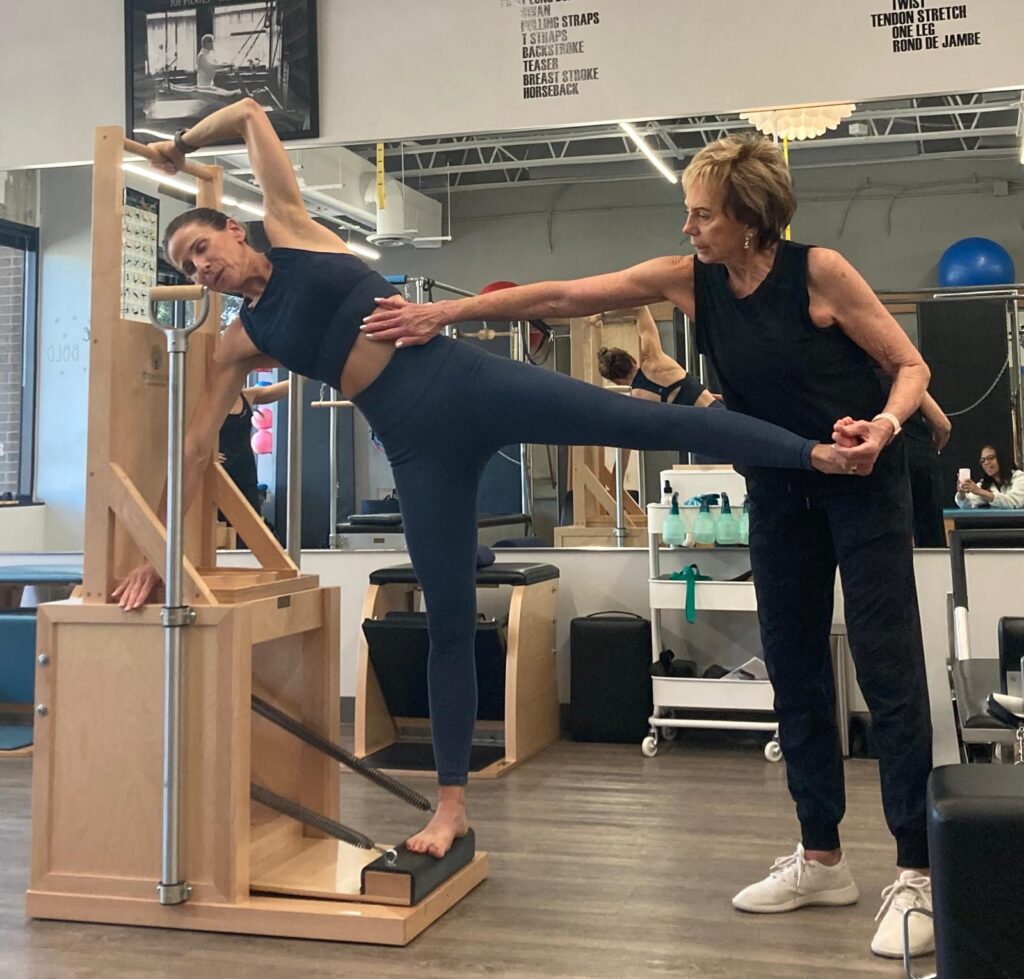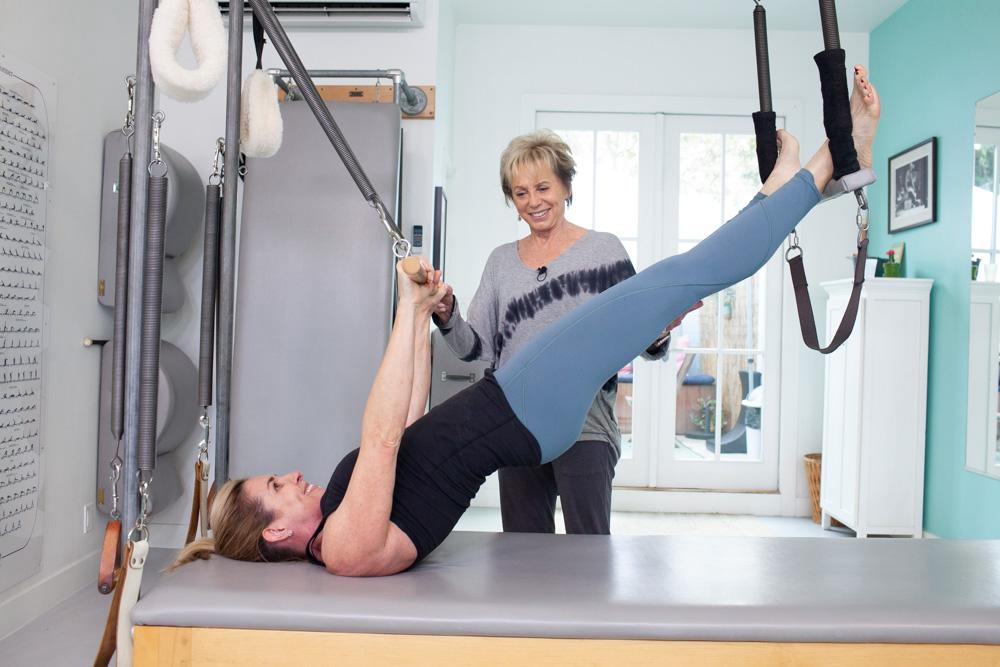Issue #435
Wednesday, June 19, 2024
“I never intended to be a Pilates teacher”
An interview with Sonjé Mayo – a student of JP!
Part 2
by Tricia Whitlock
Sonjé returned to South Africa in 1972, determined to start her own contemporary, multi-racial dance company. It was a very challenging time to do this, with Apartheid in full swing. She decided to teach them “a Method that I studied in the USA” after she saw that they lacked technique, strength, and flexibility. She did not call it Pilates, and did not offer it outside the dance company.
Tricia: What happened when you taught them the Method on the Mat?
Sonjé: Consequently, they became incredible dancers and were very popular! They were natural movers, but the Method gave them the strength and technique that was lacking. The audience LOVED them and the company, JAZZART, is still going strong today! To be clear, I did not teach it to anyone besides my dancers, she says. In the early 1980’s, a woman named Danielle went to the USA to learn Pilates MAT and she brought it back to South Africa as a fitness method.
In 1992, we moved to America due to my husband’s work, and I passed the dance company on to a new owner. I choreographed for the Tennessee Contemporary Dance Company and the Nashville Ballet. I was also dancing with the Tennessee Dance Theater. Through all of this, I had scoliosis. It began to cause me pain when I was in my 50’s, and I knew my dancing days were at an end. I went to some physiotherapists, but they were not really able to help me. A PT friend of mine in London said “You should really try Pilates”, and so I came full circle!

Tricia: How did you become certified?
Sonjé: I started looking for a training program, and I remembered Romana. At the time I was training with Joe, she was teaching for Carola Trier. So I went to Drago’s in New York looking for a lesson with Romana, and they told me “she’s too booked up, but you can have a lesson with Cynthia Shipley”. Well let me tell you, Cynthia was WONDERFUL! I asked about certification, and was told it would probably take 2 years and I would have to spend a good bit of time in New York at the studio with Romana. This just wasn’t possible for me at the time with 2 children and a life in Tennessee, so I looked for alternatives and discovered several. It would not be the same as learning with Romana herself, but I was able to get a Mat certification with Bob Liekens’ Power Pilates, which was really great. Then I certified on the equipment through Peak Pilates, headed by Clare Dunphy, who had trained with Romana, so I respected her. As I went through the training, it all came back to me – his explanations, the anatomy, the movements.
Tricia: Did they know that you trained with Joe?
Sonjé: Not in the beginning, I didn’t tell them until the end because I didn’t want them to think that I was there to show off. But they saw that I knew more than the average student!
Tricia: When did the Schroth Method come into your life?
Sonjé: The pain from the scoliosis began to come back after doing Pilates for 7-8 years because I started ‘shrinking’ and the curves became worse (I have a double S curve). The vertebral compression and rotation continued to increase despite my Pilates practice. The same PT in London suggested that I check out the Schroth method, so I did. Within a week of Schroth therapy, the pain was GONE! So I decided to get certified and bring it into my teaching. Yet another certification! My tombstone is going to say “She’s dead but still learning!”
We both laugh in mutual understanding.
Tricia: What would you like to communicate to the new generation of Pilates teachers?
Sonjé: I want to see them preserve the integrity of the Method, to keep the classical method going. I do not want to see it diluted. Yes, the loss of the court case opened the door for a lot of hybrid methods, which is not a bad thing, because Pilates is a big name, and we want a lot of people to do Pilates, but as soon as someone comes to me with an hybrid training, I try and persuade them to recertify with a classical training. Classical training keeps the Method from being watered down and made into something easy and just “general fitness.” Luckily, I see that the number of classical teachers is growing, and together we have taken Pilates further and gotten better. There are so many great classical teachers and workshops out there, and I think if we keep working together as a group, we will pass on the knowledge successfully.

Tricia: Why do you think the classical method is so important?
Sonjé: Because of the safety, the intelligence behind it, and the graded order of the exercises. The order is so safe, and will really take someone from a complete beginner to advanced in an injury-free manner. Joe had all of this on his charts, he just didn’t put it all together – Romana did that for us. It’s so important to slow down. There’s no instant gratification with Pilates. If people progress too quickly or deviate from the order, they end up hurting themselves. This gives Pilates a bad name! We have to remember that it’s not about the “tricks” that you can do.
Tricia: How long will you continue teaching?
Sonjé: I’ll go on teaching as long as I can, because I love teaching. I love it because I always learn something new! I persevere and dig deep until I help a student find what they need to feel in an exercise – it’s a great challenge and if you teach that way, you will never be bored and your clients will never be bored. Joe said, “If your clients are bored, YOU are boring.”
And THAT is a very prevalent attitude in our industry – many of us feel that we could teach Pilates until the end, because it is a career that provides immense satisfaction through constant learning, challenge, and connection to a tribe of professionals that feels the same.
These days, Sonjé offers private lessons in all of her teachings at her home studio in Nashville. She offers workshops around the USA and internationally where you can experience her unique, spunky, no BS style and catch a glimpse into what it might have been like to train with Joe himself.
Tricia Whitlock is the owner of Soul Body Works, a home Pilates studio in north Texas. She began her Pilates journey at the age of 41 after having worked in corporate America for her entire adult life, transitioning into the world of health and fitness after the untimely death of her mother changed her perspective on life. Discovering Pilates changed Tricia’s life in many ways – not only did it provide the fuel for her entrepreneurial spirit, it healed her body from many years of chronic infections, sciatica and lower back pain, as well as giving her the fluid, graceful ability to move that she had always desired. Tricia owned a busy studio from 2014-2023, and then happily transitioned into a busy and fun home studio setting, where she is able to devote more time to study, gardening, creating art, traveling, and animal rescue.
When she’s not teaching, Tricia is busy running her Facebook group Traveling Pilates Instructors, a group of nearly 14,000 Pilates instructors and studio owners with the shared desire to travel and teach Pilates. If you’re not on Facebook, you can sign up for Tricia’s mailing list here: https://plain-band-67132.myflodesk.com/mcsxl70vvj.


